- Home
- Science
- Maths
- Pre - School
- Kindergarden
- 1st Grade
- 2nd Grade
- 3rd Grade
- 4th Grade
- 5th Grade
- 6th Grade
- 7th Grade
- 8th Grade
- 9th Grade
- 10th Grade
- 11th Grade
- Units
- Extra Information
- THEORY
- Angles
- Area
- Circles
- Circle: Higher Level
- Circumference
- Diagonals
- Euros
- Length
- Mass
- Mesures de les Illes Balears
- Quadrilaterals
- Place & Position
- Reflection - Translation - Rotation
- Shapes
- Shapes: Edges - Vertices - Faces
- Symmetry
- Types of Lines
- Volume
- Cookery
- Equivalent Fractions
- How do Americans add?
- How do Americans divide?
- How do Americans multiply?
- How do Americans substract?
- Maths Symbols
- Order of Operations
- Place Value
- Times Tables Chart
- Types of Graphs
- Types of Rulers
- More ...
- Much More ...
- Arts & Crafts
- Our Solar System
- Music
- Story Time
- ICT
- Projects
- Road-Safety Education
- Stretch Your Body!
- Contact
Quadrilaterals
Quadrilaterals
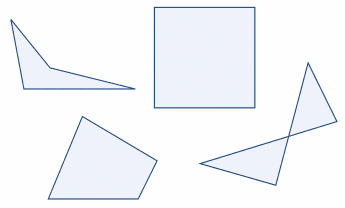
Quadrilateral just means "four sides"
(quad means four, lateral means side).
Any four-sided shape is a Quadrilateral.
But the sides have to be straight, and it has to be2-dimensional.
Properties
- Four sides (edges)
- Four vertices (corners)
- The interior angles add up to 360 degrees:
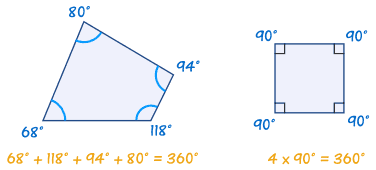
Try drawing a quadrilateral, and measure the angles. They should add to 360°
Types of Quadrilaterals
There are special types of quadrilateral:

Some types are also included in the definition of other types! For example a square, rhombus andrectangle are also parallelograms. See below for more details.
Let us look at each type in turn:
The Rectangle
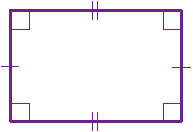
|
||
|
|
means "right angle" | |
|
|
show equal sides | |
A rectangle is a four-sided shape where every angle is a right angle (90°).
Also opposite sides are parallel and of equal length.
The Rhombus

A rhombus is a four-sided shape where all sides have equal length.
Also opposite sides are parallel and opposite angles are equal.
Another interesting thing is that the diagonals (dashed lines in second figure) meet in the middle at a right angle. In other words they "bisect" (cut in half) each other at right angles.
A rhombus is sometimes called a rhomb or a diamond.
The Square
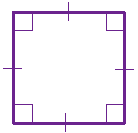
|
||
|
|
means "right angle" | |
|
|
show equal sides | |
A square has equal sides and every angle is a right angle (90°)
Also opposite sides are parallel.
A square also fits the definition of a rectangle (all angles are 90°), and a rhombus (all sides are equal length).
The Parallelogram
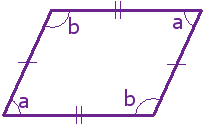
A parallelogram has opposite sides parallel and equal in length. Also opposite angles are equal (angles "a" are the same, and angles "b" are the same).
NOTE: Squares, Rectangles and Rhombuses are all Parallelograms!
Example:

A parallelogram with:
- all sides equal and
- angles "a" and "b" as right angles
is a square!
The Trapezoid (UK: Trapezium)

|
|
|
Trapezoid
|
Isosceles Trapezoid
|
A trapezoid (called a trapezium in the UK) has a pair of opposite sides parallel.
It is called an Isosceles trapezoid if the sides that aren't parallel are equal in length and both angles coming from a parallel side are equal, as shown.
And a trapezium (UK: trapezoid) is a quadrilateral with NO parallel sides:
| Trapezoid | Trapezium | |
| US: | a pair of parallel sides | NO parallel sides |
| UK: | NO parallel sides | a pair of parallel sides |
The Kite
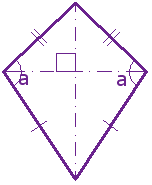
Hey, it looks like a kite. It has two pairs of sides. Each pair is made up of adjacent sides that are equal in length. The angles are equal where the pairs meet. Diagonals (dashed lines) meet at a right angle, and one of the diagonal bisects (cuts equally in half) the other.
... and that's it for the special quadrilaterals.
Irregular Quadrilaterals
The only regular quadrilateral is a square. So all other quadrilaterals are irregular.
The "Family Tree" Chart
Quadrilateral definitions are inclusive.
Example: a square is also a rectangle.
So we include a square in the definition of a rectangle.
(We don't say "Having all 90° angles makes it a rectangle except when all sides are equal then it is a square.")
This may seem odd, as in daily life we think of a square as not being a rectangle ... but in mathematics it is.
Using the chart below you can answer such questions as:
- Is a Square a type of Rectangle? (Yes)
- Is a Rectangle a type of Kite? (No)
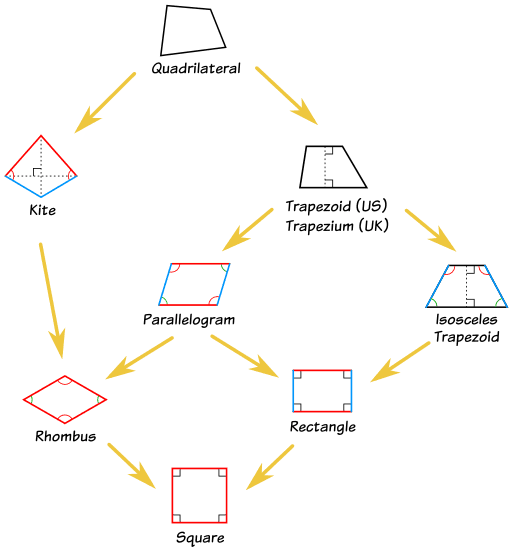
Complex Quadrilaterals
Oh Yes! when two sides cross over, you call it a "Complex" or "Self-Intersecting" quadrilateral like these:

They still have 4 sides, but two sides cross over.
Polygon
A quadrilateral is a polygon. In fact it is a 4-sided polygon, just like a triangle is a 3-sided polygon, a pentagon is a 5-sided polygon, and so on.
Play with Them
Now that you know the different types, you can play with the Interactive Quadrilaterals.
Other Names
A quadrilateral can sometimes be called:
- a Quadrangle ("four angles"), so it sounds like "triangle"
- a Tetragon ("four and polygon"), so it sounds like "pentagon", "hexagon", etc.

